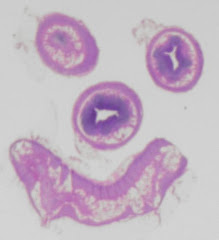I cannot emphasize enough the importance of having grossing procedures in place. This may sound like a simplistic statement, especially for those of you who have always had procedures to which you can refer, but for those of you who do not have the benefit of a procedure manual, its benefits may not be immediately obvious.
The creation of a grossing procedure should involve all appropriate staff members before the final version if put into force. All should have the opportunity to read, to make inquiries, and to offer comments or criticism to a new procedure during its writing. Those with additional special knowledge, including broader available resources (eg. the College of American Pathologists), should especially be consulted. From these sources, insights into the rationale for handling a particular specimen in a particular way can be added to the procedure. Once the final version has been agreed upon, it should be distributed to all (or its location on the network -- or shelf -- provided). The procedure is then recognized as constituting 'best practice' and will apply to all cases. All staff will read, and document that they have done so, the manual (annually). This will afford the opportunity for periodic revision of the procedure.
When grossing, the procedure shall be adhered to in all cases except where cases dictate that certain deviations are appropriate (in this instance, the identity of the pathologist with whom the case was reviewed shall be given in the Gross). The knowledge that cases will be handled in a particular manner provides stability and consistency to the quality of the provision of care that a pathology department is able to provide. Everyone knows where they stand -- and where everyone else stands. Quality systems prescribe that procedures must be in place for this reason. The complete manual instantly becomes the primary training resource and reference for newcomers to the gross room, whether PA or Resident Pathologist. Those working in the gross room benefit by knowing that, abiding by the manual, they are providing the best possible 'product' and thus derive a sense of belonging, security and even pride -- rather than operating in a vacuum without valuable information; yet still expected to provide a consistent, excellent product. This scenario may result in a feeling of alienation and fear and resentment by the PA. The manual may provide a reference in the instance where a patient has a question concerning the handling or her/his specimen and thus gives a feeling of confidence to the patient, and her/his clinicians; that consistently high quality of care was provided.
Grossing templates are a form of procedure; they also go a long way to providing quality and consistency in grossing (in the same manner in which microscopic synoptic reports provide quality and consistency to the diagnosis of cancer cases). PAs are very good at following procedures, as long as they are aware of them. If a procedure is NOT in place, who is at fault for not following it? Here's another: Who is at fault if special knowledge is not disseminated and a specimen is handled inappropriately as a result? Who judges that which should be known? How is it documented that information has been disseminated, read and understood? How is competency determined?
It is the responsibility of all, but especially of the pathologists whom we assist (they're the ones who sign the reports), for the sake of our patients, that all special knowledge affecting the appropriate handling of all specimens be communicated. Official lines of communication between pathologists (those who are responsible for having the special knowledge) and PAs (those responsible for employing parts of that special knowledge) are generally undefined. Assumptions should not be made and the process should be transparent to all.
Sunday, September 30, 2007
Subscribe to:
Post Comments (Atom)



No comments:
Post a Comment